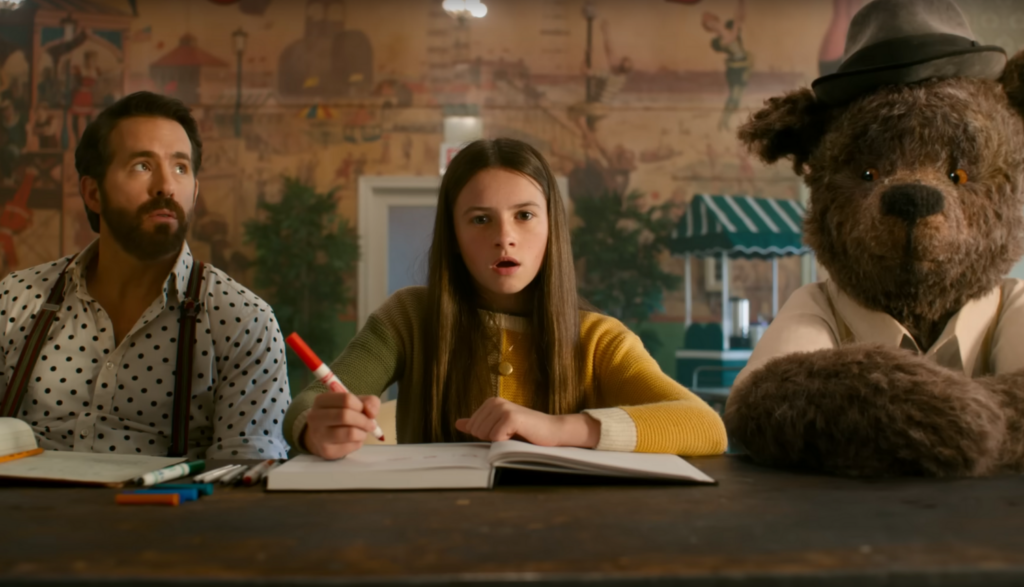
Twelve-year-old Bea is having a tough go of things. You see, she lost her mom when she was little, and now her dad is sick, too. And he has to have an operation at the same New York City hospital that Bea’s mom was in.
It’s good that Bea’s grandmother lives nearby, so Bea can stay with her. But the tween is finding life difficult right now.
Don’t get me wrong, Dad is still playful and full of jokes, like usual. He’s trying to keep things light and help Bea find fun in life’s tricky moments. But Bea can’t help but stop and tell him, “Sometimes, life doesn’t have to be fun.”
Dad agrees, with an assuring smile and a warm hug. He tells her to go on out and “explore her own story” while she’s here. Figure out how everything fits. But he tells her … to have a little fun, too.
Then something unexpected happens.
After returning to her grandmother’s apartment, Bea spots an odd little figure fliting in and around the building’s shadows. At first, she thinks it’s a young girl. But when getting closer, she realizes this person looks like a 1930s cartoon version of an anthropomorphized butterfly.
Hmmm. How very strange.
Bea secretly follows the creature back to the apartment of a man named Cal. And after forcing him to talk to her, Bea finds out that the amazing-looking character, called Blossom, is none other than an “IF”: an Imaginary Friend.
You see, imaginary friends are often left behind, Cal tells the girl. They help their young human pals through tough times, but then the kids tend to forget all about them once they grow up.
Cal has the ability to see all the left behind imaginary friends in the world. Just as Bea apparently can. And after Cal shows Bea to a retirement home full of bizarre and wonderful IFs, she is ready to lend a hand.
Bea determines to spend her time at grandmother’s helping Cal find new homes for the lonely IFs. And maybe they’ll reconnect some IFs with their now grown-up kids, too.
What Bea doesn’t realize, however, is that there might be a big part of her own story that she’s about to connect with as well.
We see a nice video montage of a 6-year-old Bea dancing and playing with her mom and dad. As we near the end of this collection of family moments we realize that Bea’s mom is dealing with an illness that wasn’t obvious in the earlier scenes. Mom asks her to tell a story: Bea’s story. In narration, an older Bea thinks back on those moments and tells us, “I realized that the most important stories we have to tell are the ones we tell ourselves.”
This insight later plays into the narrative that 12-year-old Bea tells her Dad, who is seemingly unconscious and just out of surgery. She talks of the things that she’s learned about herself and others. She notes that her dad’s love is vital, and she says his embrace is one of the only places she feels completely safe. Bea emotionally declares that he must stay with her. And her groggy father, stirs and tells her it was a really good story.
Bea also digs up an old, forgotten video camera that she finds in her grandmother’s closet. She wistfully looks upon those forgotten images. In that light, when Cal takes Bea to a “special” place where the IFs live, she asks him if it’s a magical place. He tells her it used to be. And it turns out that the IFs’ residence is beneath Coney Island—the very place where Bea and her mom and dad recorded some of the videos.
The film also makes it clear that remembering the past—the highs the lows, the sweet moments, and difficult challenges—make us better, more thankful people. In the course of things, for instance, adults who reconnect with memories of their forgotten IFs find themselves happily flashing back on valuable lessons and joys they once experienced. (The IFs likewise glow happily in those momentary connections. They celebrate with other IFs over those short but potent reconnections.)
[Spoiler Warning] The IFs collectively worry that if they are forgotten, then they won’t be needed. And if they aren’t needed, they’ll cease to matter or exist (some of the very feelings that lonely people sometimes have, too.) We eventually discover that Bea has an imaginary friend whom she forgot, too. She accidentally realizes her misstep and apologizes. Bea thanks him for his past help and declares that she’ll always remember and need him going forward.
The only spiritual-like elements in the mix are things of imagination.
For instance, an older IF named Lewis tells Bea that the IFs’ “retirement home” domain can be positively changed with just a little imagination. So Bea uses her imagination to magically transform the generally dour place into a building that’s vibrant with song and dance. Ultimately, all the IFs gather in a rock concert-like celebration with a classic Tina Turner song. (Tina shows up and joins in, too.) A ghost is one of the IFs. One imaginary friend calls Bea the “chosen one.”
While visiting the IFs, Bea and Cal walk in on an IF art class that’s painting an IF “model.” The apple-with-stick-legs IF quickly grabs a towel to cover it’s “nakedness.” Cal tells a banana-like IF to put on some pants. “You’re freaking everybody out,” Cal says as the embarrassed IF covers its lower banana extremities.
Bea meets a young boy at the hospital who says he falls a lot. He has a broken leg, arm and tailbone. (He calls it a “broken butt.”)
When Bea first comes face to face with two different imaginary friends, she faints and falls to the ground.
A burning marshmallow IF melts, dropping its eye to the tabletop. A giant puffball-like IF named Blue has a few panic attack moments that Cal states could lead to a blow up. (Each is diffused at the last moment.)
The dialogue includes about two dozen misuses of God’s name. Those are joined by one use of “gosh” and two uses of “h—.”
None.
A giant Gummy Bear IF nervously passes gas. Cal breaks into a kid’s bedroom to retrieve Blue. There’s some talk of needing to vomit.
There’s something refreshingly lovely about a family-focused film that doesn’t choose to jump through the same old problematic hoops.
IF, written and directed by actor John Krasinski, is one such film. It’s original and creative and sets something of a new gold standard for its brilliant blending of CGI and live action characters. The film talks about navigating loss, remembering the good things of the past and finding your place in the world. At the same time, this pic lauds the love of family and the special connection between dads and daughters.
Drawbacks? Well, God’s name is misused quite a few times. That will likely be the primary content concern for many families. And we get a couple of winking gags about “naked” fruit characters that might cause a parent to roll his or her eyes.
Story-wise, the fact is the early chapters of this tale can be a little confusing for younger viewers. (It’s all made very clear by the conclusion in a few tearfully sweet moments.) That said, when those silly imaginary friends are mixed with a few snacks, the result is a mostly family-friendly story with some nice messages.


After spending more than two decades touring, directing, writing and producing for Christian theater and radio (most recently for Adventures in Odyssey, which he still contributes to), Bob joined the Plugged In staff to help us focus more heavily on video games. He is also one of our primary movie reviewers.
Our weekly newsletter will keep you in the loop on the biggest things happening in entertainment and technology. Sign up today, and we’ll send you a chapter from the new Plugged In book, Becoming a Screen-Savvy Family, that focuses on how to implement a “screentime reset” in your family!